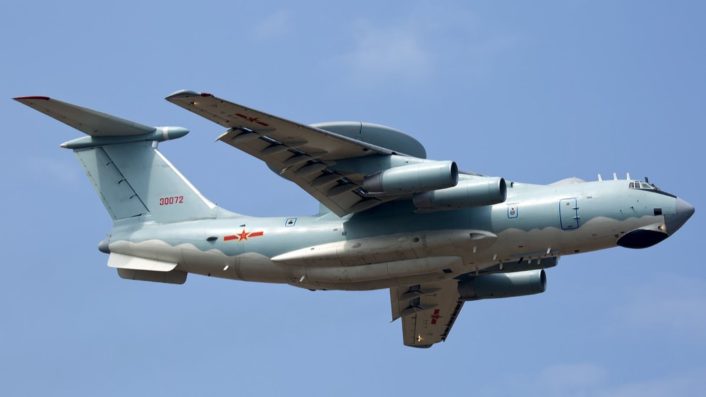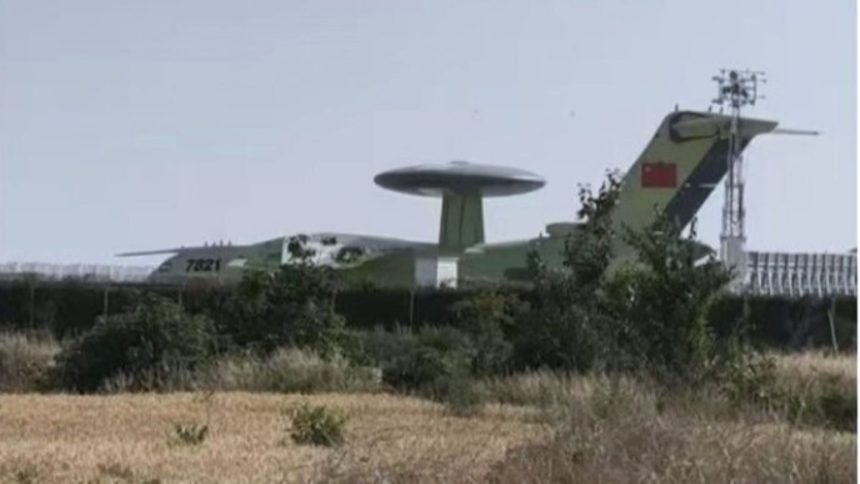The KJ-3000 is based on the Y-20 strategic airlifter, and its development is consistent with the Chinese doctrine to have a varied fleet of airborne radars.
Within five months of the first grainy visuals of China’s newest and largest Airborne Early Warning and Control (AEW&C) aircraft, the KJ-3000, performing its maiden flight on Dec. 27, 2024, the aircraft was now photographed in an unofficial image on the Chinese internet, sporting a factory primer paint at an unidentified air base.
This image immediately followed a heavily pixelated one that shrouded the side fuselage and sections of the vertical stabilizer. Another set of images and a video captured from the ground show the KJ-3000 flying overhead, although it is not clear if this was the same aircraft or a clearer version of the footage that emerged in Dec. 2024.
Regarding the image in question, leading Chinese military aviation researcher Andreas Rupprecht noted the airframe number 7821 painted on the fuselage, calling the aircraft a prototype of the KJ-3000. The KJ-3000 is based off of the Y-20 series of strategic cargo aircraft, where the ‘KJ’ stands for 空警 or Kōngjǐng, which literally means ‘Air Police’. The KJ-3000’s existence has been rumored for a few years now.
And here the uncensored one: It‘s number 7821 https://t.co/XlC9TFoJkt pic.twitter.com/y7Tq635TtR
— @Rupprecht_A (@RupprechtDeino) May 27, 2025
Developed by Xi’an Aircraft Corporation (XAC), the Y-20B is an upgraded Y-20 powered by WS-20 high-bypass turbofan engines in place of the Russian D-30KP-2. Another variant in the series is the YU-20/YY-20A aerial refueling aircraft, which has a three-point hose-and-drogue refueling system.
The KJ-3000 is consistent with a noted Chinese effort to have a large fleet of AEW&C aircraft for both redundancy and enhanced situational awareness for the vast maritime distances of the western Pacific.
— お砂糖wsnbn (@sugar_wsnbn) May 26, 2025
New capability replacing the KJ-2000
Like the Russian A-50U Mainstay and A-100 AEW&C aircraft and NATO/U.S.’ E-3 Sentry AWACS (Airborne Warning and Control System), the Shaanxi KJ-3000 has a large rotating radome disc on the top of the fuselage. Becoming the largest AEW&C plane in the PLA Air Force fleet, it was developed to replace the other existing type in service, the KJ-2000.
The second-generation airborne radar is based on the Russian Ilyushin Il-76 aircraft modified by SAC and a phased array radar disc developed by China Electronics Technology Group Corporation (CETC). It made its first flight in 2003.
Little information is available on the KJ-3000’s capabilities, with claims about Gallium Nitride (GaN)-made Transmitter/Receiver (T/R) in a dual-band system. This however cannot be verified and is still within the realm of speculation.
The latest image also shows an aerial refueling probe above the left-hand-side of the cockpit, and an array of blades on the dorsal-side, which could be High/Very-High/Ultra-High (HF/VHF/UHF) communication antennae.
Any fairings on the side or the tail end, which could be associated with Electronic Intelligence/Electronic Support Measures (ELINT/ESM), are not visible. However, this capability cannot be ruled out, given how they have emerged as elementary features in modern AEW&C aircraft, and might be visible in more clearer images in the future.

KJ-700, KJ-600 and the WZ-9 Divine Eagle Unmanned AEW&C
The KJ-700 that was captured in images in June 2024, has been assessed by Rupprecht to be a more advanced version of the “baseline KJ-500H AEW,” with a “mid-life upgrade (MLU) to a multirole ISR-type.” The new aircraft sported a different nose section, a dome under the chin, a larger bulge on top of the radar disc and a larger side array on the rear fuselage’s sides.
The navalised KJ-600, a twin-turboprop carrier-borne AEW&C plane meant to operate from the Fujian aircraft carrier, is another addition to the fleet. It can be considered roughly equivalent to the E-2C/D Hawkeye. The carrier, with its EMALS (Electromagnetic Launch System), can launch and recover heavier aircraft, including the fixed-wing AEW&C aircraft. The Shandong and the Liaoning carriers, with STOBAR (Short Take-Off But Arrested Recovery) configuration with a ski-jump, only operate rotary-wing AEW&C platforms.
Ok, it goes on and on and on: second surprise this morning, the new KJ-3000 (?) AEW performed its maiden flight at XAC and from what can be seen on the first few small & blurry images, it is as expected a Y-20B-based design featuring a large rotodome but also a bulge on the tail. pic.twitter.com/MTp9A6dfDh
— @Rupprecht_A (@RupprechtDeino) December 27, 2024
The PLAAF’s WZ-9 Divine Eagle, meanwhile, is China’s most curious and unconventional AEW&C platform, being the world’s first-of-its-kind unmanned aircraft for the role. Visuals of the UAV flying overhead and previous scale models and concept renditions showed its unusual design.
The aircraft is based around a twin-boom structure, with a smaller wing acting as horizontal stabilizer in the front and the main wing in the rear, and two vertical stabilizers. The main wing also connects the two booms/fuselages, while a single jet engine sits atop the main wing between the two booms and vertical stabilizers.
Well … according to some rumours, the PLAAF’s next-gen AEW platform – successor to the KJ-500 and complement to the larger KJ-3000 – will be named KJ-700.
Interesting are the changes at this site: in the middle is supposed to be the KJ-3000’s radar right the KJ-700‘s one. pic.twitter.com/u6QkLJeI35
— @Rupprecht_A (@RupprechtDeino) December 17, 2023
Other AEW&C aircraft
Rupprecht has previously given a broad overview of the diverse inventory of AEW aircraft in service with the PLA. He called the KJ-2000 AEW&C an indigenous variant of the Russian A-50 Mainstay by the Xi’an Aircraft Corporation (XAC) with a Type 88 radar installed.
Another operational AEW platform is the Shaanxi Aircraft Corporation (SAC) Y-8J, based on the Y-8 turboprop transport and used by PLA naval aviation. Developed under Project 515 and first spotted near Shanghai in 2000, it features a British Skymaster surveillance radar housed in a prominent bulbous and partially drooped nose radome.
KJ-600 艦載AEW&C “7103” pic.twitter.com/kRzfX1d8yb
— お砂糖wsnbn (@sugar_wsnbn) March 23, 2024
The Y-8W/KJ-200 is China’s second smallest tactical AEW&C type, based on the Category III airframe of the Y-8, with a redesigned fuselage featuring a solid nose and a new tail section with the loading ramp removed. The KJ-500, meanwhile, is based on the Y-9 airframe and is used by both the PLA Air Force (PLAAF) and PLA Naval Aviation.









